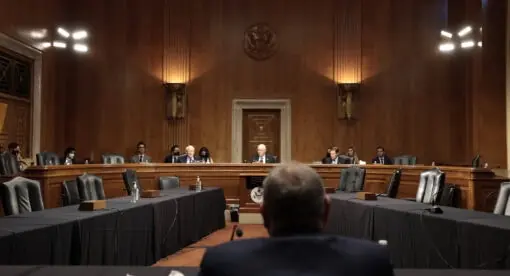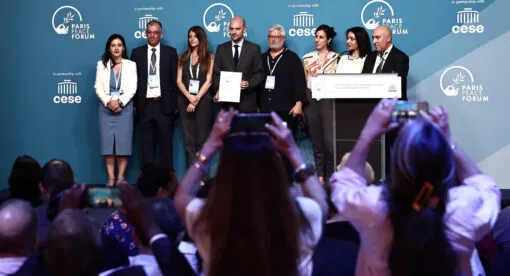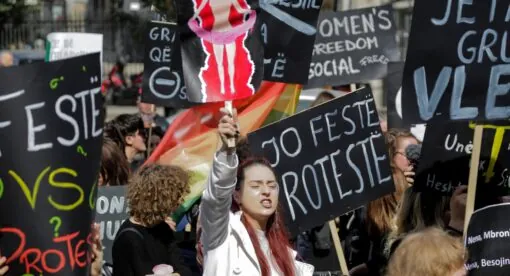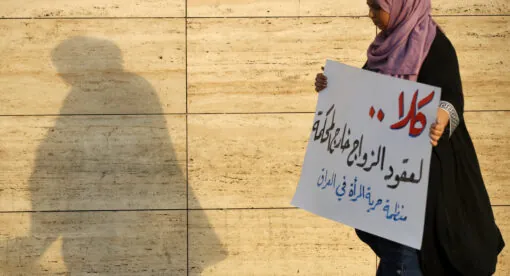The Weekly Forecast Monitor is a forward-looking assessment of geopolitical dynamics shaping our world. To get more in-depth analysis of these issues and learn more about analytical products from New Lines Institute — including simulations, training sessions, and forecast reports — contact us at [email protected] and visit https://newlinesinstitute.org/analytical-products/. Download PDF version.
Global Hotspots
The Global Hotspot Tracker examines the outlook for key geopolitical hotspots around the world. (Go to the Global Connectivity Tracker)
Middle East
Summary – Tensions in the Middle East trended toward military escalation and diplomatic de-escalation scenarios. The Israel Defense Forces (IDF) expanded operations in Gaza, and tensions between Israel and Hezbollah increased. Mediators pressed Hamas and Israel to agree to a cease-fire proposal.
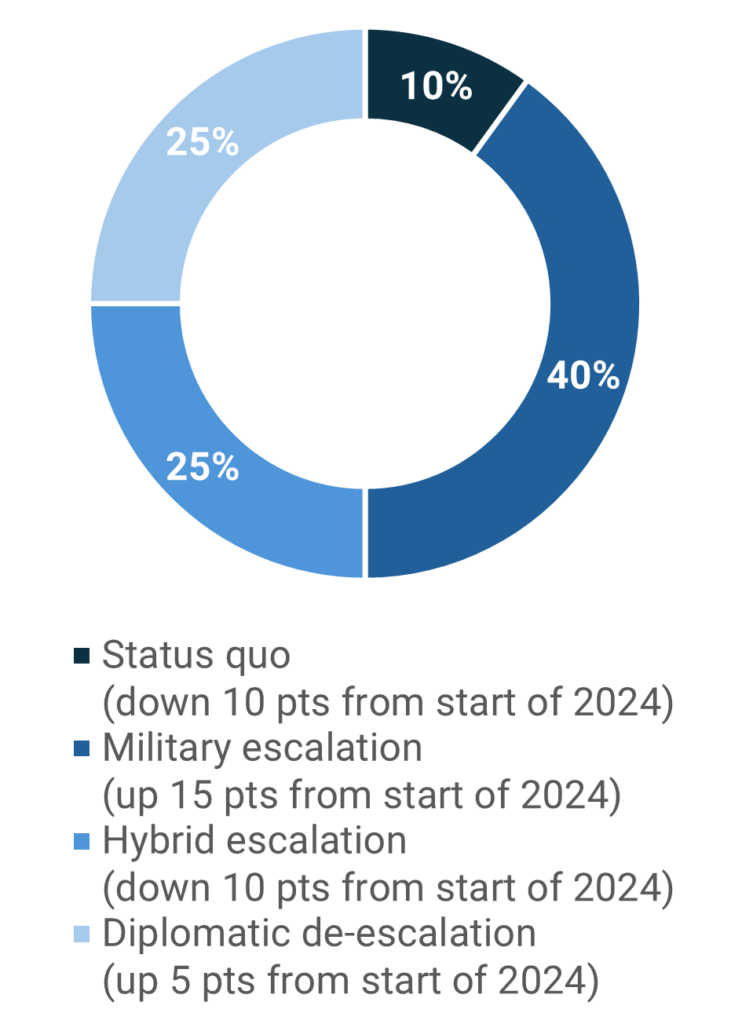
Military escalation scenario
- Israel carried out airstrikes and expanded operations in Rafah.
Risk level – medium - The IDF began operations near Bureij and Deir al-Balah in central Gaza and conducted airstrikes across the territory, including striking a U.N. school.
Risk level – medium - Rockets fired by Hezbollah caused bushfires in northern Israel, prompting Israeli Prime Minister Benjamin Netanyahu to threaten retaliation. The IDF said one soldier was killed in the clashes.
Risk level – high - A Syrian national opened fire on the U.S. Embassy in Beirut, shooting a Lebanese guard outside the facility.
Risk level – low - The IDF carried out raids in the West Bank city of Jenin, killing three Palestinians and wounding more than a dozen.
Risk level – low
Hybrid escalation scenario
- Al-Houthi rebels claimed they targeted three vessels in the Red and Arabian seas. The U.S. and its allies are pursuing ways to counter al-Houthi financing.
Risk level – low
Diplomatic de-escalation scenario
- The cease-fire proposal announced by Biden was met with international and regional support. Mediators are pressuring Hamas to agree to the terms. Netanyahu faces pressure from moderates and the ultra-Orthodox, but some far-right leaders have threatened to leave Netanyahu’s coalition if the deal is accepted.
Opportunity level – low
Russia/Ukraine Conflict
Summary – The Russia-Ukraine conflict is trending toward military and hybrid escalation scenarios. Russia warned it could strike against Western targets and military instructors operating in Ukraine, while Ukrainian forces hit missile systems inside Russian territory using Western weapons. Ukraine made efforts to increase participation in a peace summit next week, while Russia worked to dissuade countries from participating. Moscow is making a diplomatic and security push in Africa.
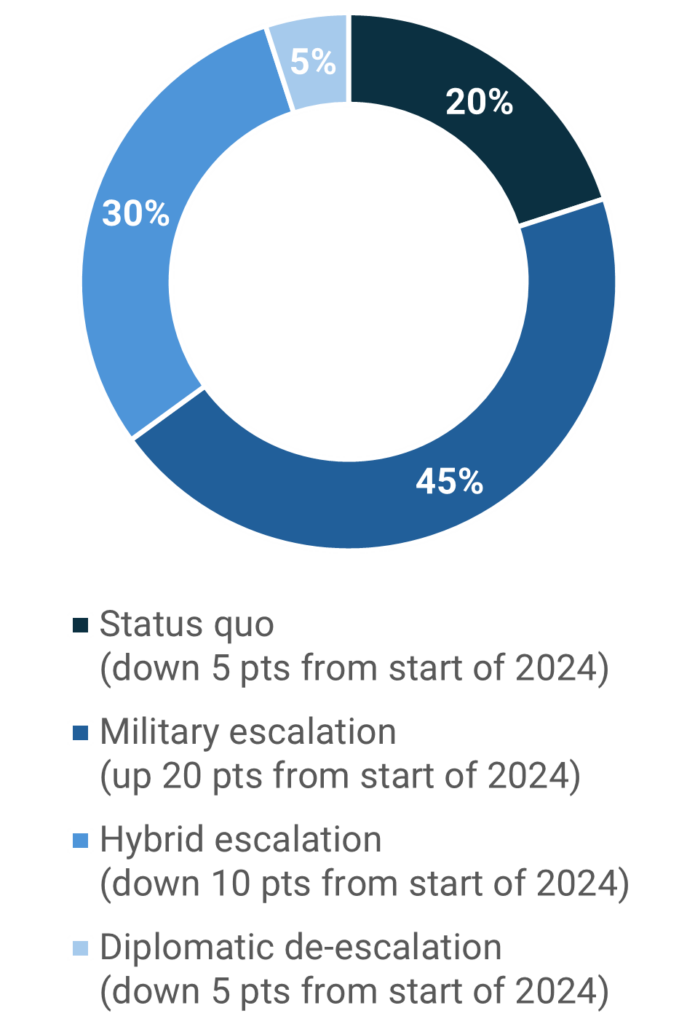
Military escalation scenario
- The Kremlin warned that Western military instructors would not be immune to Russian strikes following reports that France could send military trainers to Ukraine. Russian President Vladimir Putin also warned that Russia could supply weapons to countries aiming to attack Western targets.
Risk level – medium - Ukraine claimed it hit a Russian S-300 missile system inside Russian territory using weapons provided to it by Western countries.
Risk level – medium - Russian forces claimed to have captured the village of Umanske in the Donetsk region of eastern Ukraine.
Risk level – low
Hybrid escalation scenario
- A leaked EU discussion paper claimed the U.S. proposed that its $50 billion loan to Ukraine be repaid by profits gained from Russian assets frozen by the West in exchange for the EU agreeing to extend sanctions against Russia until the end of the war.
Risk level – medium - Russia will be sending additional military instructors to Burkina Faso and is set to sign a military cooperation agreement with Sudan that includes access to Port Sudan.
Risk level – low - Ukraine conducted a large-scale cyberattack against Russian companies and government ministries, according to Russia’s state communications regulator.
Risk level – low - Russia’s imports fell 10% year-on-year from January to April after U.S. threats of secondary sanctions against countries like China, whose exports to Russia have fallen by 14% year-on-year in dollar terms.
Risk level – low
Diplomatic de-escalation scenario
- Ukraine has received confirmation from 107 states and international organizations to attend a global peace summit held in Switzerland on June 15 and 16. Ukrainian President Volodymyr Zelenskyy attended an Asian security summit in Singapore and traveled to the Philippines to recruit participants for the peace summit. Zelenskyy accused Russia and China of attempts to undermine the summit and dissuade countries from attending. Pakistan, Brazil, and Saudi Arabia announced this week that they would not attend the summit.
Opportunity level – low
U.S./China/Indo-Pacific
Summary – Tensions in the Indo-Pacific trended toward military and hybrid escalation scenarios, as South Korea suspended its military agreement with North Korea and resumed military activities near the demarcation line. In the South China Sea, China accused Philippine troops of pointing guns at its coast guard personnel and alleged the Philippine navy cut Chinese fishing nets near the Second Thomas Shoal. Australia’s Treasury Ministry ordered Chinese investors to sell their shares in Northern Minerals, a rare earth company.
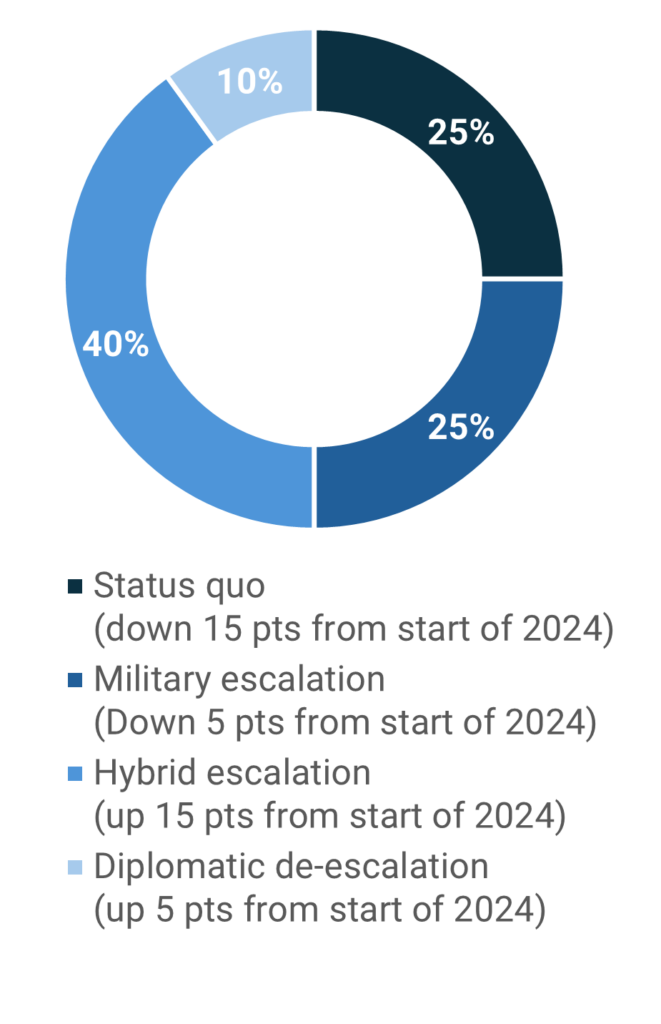
Military escalation scenario
- After South Korea suspended its military agreement with North Korea in retaliation for last week’s trash balloon incident, the U.S. and South Korea conducted joint fighter jet trainings.
Risk level – medium - China accused Philippine troops of pointing guns at Chinese coast guard personnel in a confrontation during a routine mission to resupply Philippine troops in disputed waters. The Philippines said the troops were holding guns but deny the guns were pointed at Chinese personnel.
Risk level – medium - Philippine President Ferdinand Marcos Jr. said at the Shangri-La Dialogue in Singapore that the hypothetical death of a Philippine citizen at the hands of China would be “very close to what we define as an act of war.”
Risk level – low
Hybrid escalation scenario
- China accused Philippine troops of cutting and removing Chinese fishing nets near the disputed Second Thomas Shoal. The Philippines accused China of blocking a Philippine medical evacuation from the shoal.
Risk level – low - South Korean President Yoon Suk Yeol hosted the country’s first summit with African countries to discuss economic cooperation and establish the Korea-Africa Critical Mineral Dialogue in an attempt to counter China’s influence over critical minerals.
Risk level – low - South Korean activists continued launching balloons carrying anti-Pyongyang flyers into North Korea.
Risk level – low - A cyberattack targeted Australian rare earth mining company Northern Minerals a day after the country’s Treasury Ministry ordered Chinese shareholders to sell their stocks in the company.
Risk level – medium
Diplomatic de-escalation scenario
- No major indicators
Global Connectivity
The Global Connectivity Tracker examines the sectoral impact of geopolitical dynamics on key themes like the global energy/climate transition, trade, and technology. (Go to the Global Hotspot Tracker)
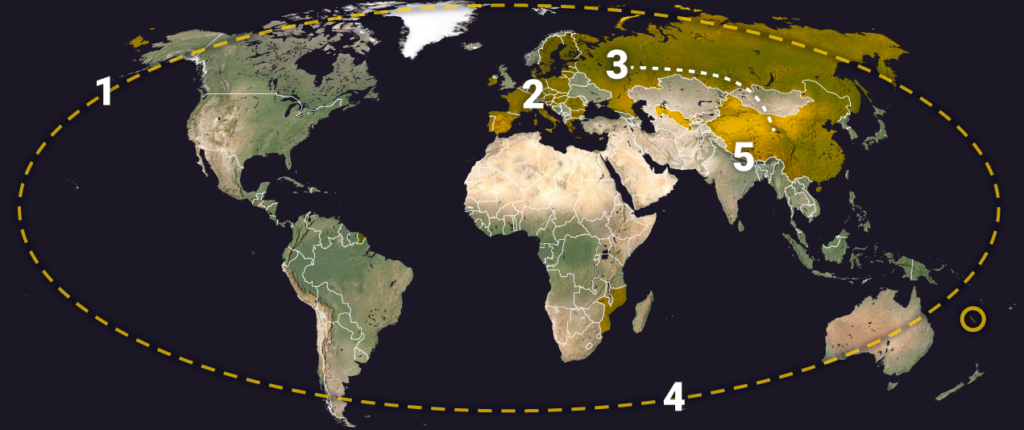
Energy/Climate
- Global: Oil
What happened: OPEC+ decided most of its members would continue to limit oil production until at least 2025 to boost the market amid weak demand growth, high interest rates, and rising U.S. crude output.
Significance/Outlook: The price of Brent crude oil has dropped to $80 per barrel, affected by rising oil reserves in developed economies and concerns about the weak demand growth in China, a major oil importer. OPEC+ countries are decreasing output by 5.86 million barrels per day (bpd), or 5.7% of world demand. These included 3.66 million bpd of cuts expiring in 2025 and 2.2 million bpd of voluntary reduction by eight countries expiring in September 2024. The cuts might raise oil prices in the coming months. Typically, demand experiences a surge from July to September.
Risk level – low/medium - EU: Energy
What happened: A growing share of renewable energy is displacing fossil fuels in Europe’s power grid.
Significance/Outlook: One-fifth of the fossil fuel power generation in the European Union was replaced by electricity generated by solar and wind between 2019 and 2023. The national targets of the EU member states are getting close to what is needed to satisfy REPowerEU targets, but a further push is needed to close the remaining gap and accelerate deployment. The REPowerEU initiative’s goals are to reduce reliance on fossil fuels imported from Russia and to accelerate action to combat climate change.
Opportunity level – medium - Russia/China: Natural Gas
What happened: The gas pipeline project between Russia and China has been halted due to Beijing’s price demands.
Significance/Outlook: Gas from Russia could be strategically important to China since it is not dependent on shipping routes that could be disrupted in the event of a naval conflict near Taiwan or the South China Sea. Nevertheless, for such a deal to be worthwhile for Beijing, China needs a price that is extremely low and obligations that are flexible. Since Russia’s pipeline gas exports to Europe have dropped significantly following Russia’s full-scale invasion of Ukraine, Gazprom will likely have to give in to China’s demands. Prior to the conflict in Ukraine, Gazprom relied on selling gas to Europe at high rates to generate revenue. In the decade before the Ukraine invasion, Gazprom exports to Europe averaged 230 billion cubic meters (bcm) per year, but in 2023 they had dropped to 22 bcm.
Risk level – low/medium - Global: Shipping
What happened: The continual transit of sanctioned oil and petroleum products from countries like Russia, Iran, and Venezuela is exacerbating the threat of climate change.
Significance/Outlook: One of the many challenges of sanctioned tankers is the effect they have on climate change. The fact that they pass under the radar is making it difficult to track the greenhouse gas emissions these tankers produce. The International Maritime Organization aims to achieve net-zero greenhouse gas emissions by 2050, and this “dark fleet” derails its efforts. The dark fleet also tends to use the cheapest fuel available and has no incentive to comply with international emissions regulations. This problem has intensified with the Russian invasion of Ukraine and the sanctions on the Russian energy sector, which, if continued, will harm the environment.
Risk level – low/medium - China/Nepal: Gas
What happened: China is funding an exploration project in Nepal to search for oil and gas, potentially helping Nepal reduce its reliance on fossil fuel imports from India.
Significance/Outlook: The exploration is taking place in Dailekh District in Nepal, with 20 Chinese engineers and 45 Nepali technicians. The drilling is projected to reach depths of up to 4 kilometers and is expected to last six months. This project is part of a 2007 agreement between China and Nepal to evaluate oil and gas reserves, and it will be the first oil and gas exploration in Nepal since 1985. If it yields successful results, it will have significant benefits for the Nepali economy and help reduce its overreliance on Indian crude oil. Self-sufficiency in energy supply will help Nepal better balance its foreign policy approach between India and China.
Opportunity level – low
Key Stats of the Week
- The EU increased its wind and solar power generation by 46% between 2019 and 2023.
- Capacity installations increased by 65%, with wind power increasing by 31% to 219 GW and solar capacity more than doubling to 257 GW.
- Coal generation made up 8.6% of the EU’s energy mix in April 2024, its lowest percentage ever, and gas-fired generation made up 12.1%, its lowest share in eight years.
Source: Reuters


